
Photo by Danielle MacInnes on Unsplash
Il y a un mois de cela, j’écrivais un article sur la Conception d’une rétrospective à l’aide des Liberating Structures. Le jour J est finalement arrivé, et comme rien ne se passe exactement comme prévu, je vous propose de décrire ce qu’il s’est véritablement passé pendant cet atelier !
Comme à mon habitude, des éléments de structure, d’ambiance et de contenu !
Bonne lecture 🙂
Rappel du plan initial
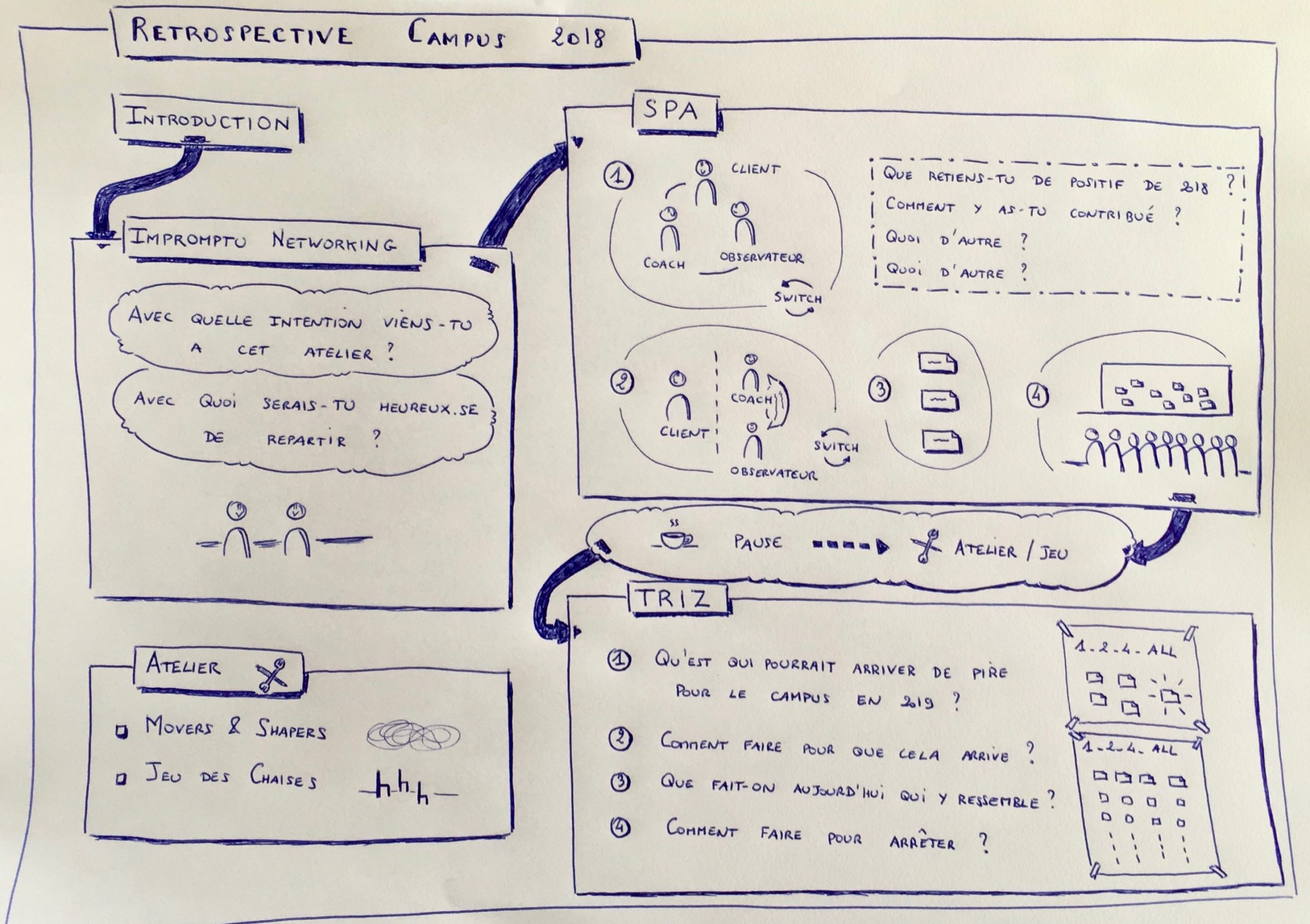
Voici ce qui était initialement prévu pour cette rétrospective (avec un timing hypothétique) :
| Timing | Contenu |
| 9h30 | Introduction |
| 9h35 | Impromptu Networking |
| 9h50 | SPA |
| Étape 1 : Partage avec Client, Coach et Observateur | |
| Étape 2 : Conversation à 2 entre Coach et Observateur | |
| Étape 3 : Sélection des idées principales | |
| Étape 4 : Partage en grand groupe | |
| 10h20 | Pause |
| 10h40 | Movers and Shapers |
| 10h55 | TRIZ |
| Étape 1 : Choix de la problématique principale à étudier | |
| Étape 2 : Définition de la stratégie pour atteindre ce résultat | |
| Étape 3 : Rapprochement avec la situation actuelle | |
| Étape 4 : Stratégie pour arrêter les actions contre-productives | |
| 12h00 | Débriefing |
| 12h30 | Fin de l’atelier |
Voyons ce qu’il s’est véritablement passé ! 🙂
Introduction
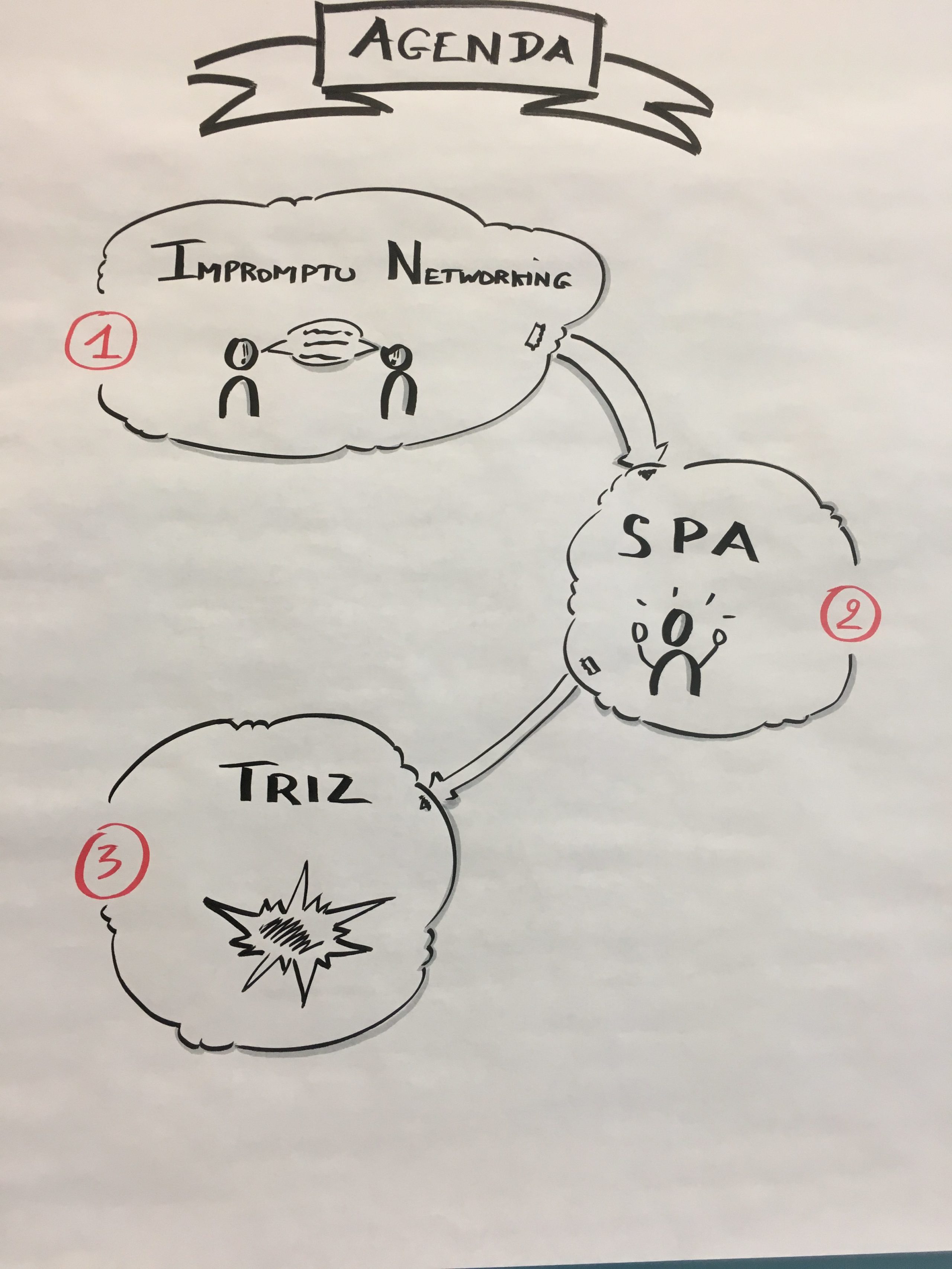
Comme à mon habitude, j’arrive une bonne heure en avance afin de préparer mes affiches et échanger quelques mots avant la session avec les sponsors. Une information qui m’interpelle est que l’équipe est conviée à 9h30 pour le petit-déjeuner ce qui signifie que l’animation ne commencera véritablement qu’à 10h.
| Note : une adaptation du timing sera donc à prévoir sachant que l’heure limite de 12h30 est fixe, le programme de l’après-midi étant déjà bien ficelé. |
Le moment de l’introduction arrive donc tranquillement avec un démarrage avec les sponsors comme je le recommande la plupart du temps. En effet, cela donne une impulsion supplémentaire au groupe, du sens à tout ce qui va suivre et me permet dans le même temps de prendre le mandat sur le cadre.
Je présente alors l’agenda en indiquant aux participant.e.s que la session sera composée de 2 grandes parties :
- Une rétrospective – afin de regarder en arrière et acter de ce qui a été réalisé ensemble
- Une perspective – afin de regarder en avant et faire les premiers pas vers cette nouvelle année avec énergie
Nous nous lançons ensuite dans la première phase : l’Impromptu Networking.
Impromptu Networking
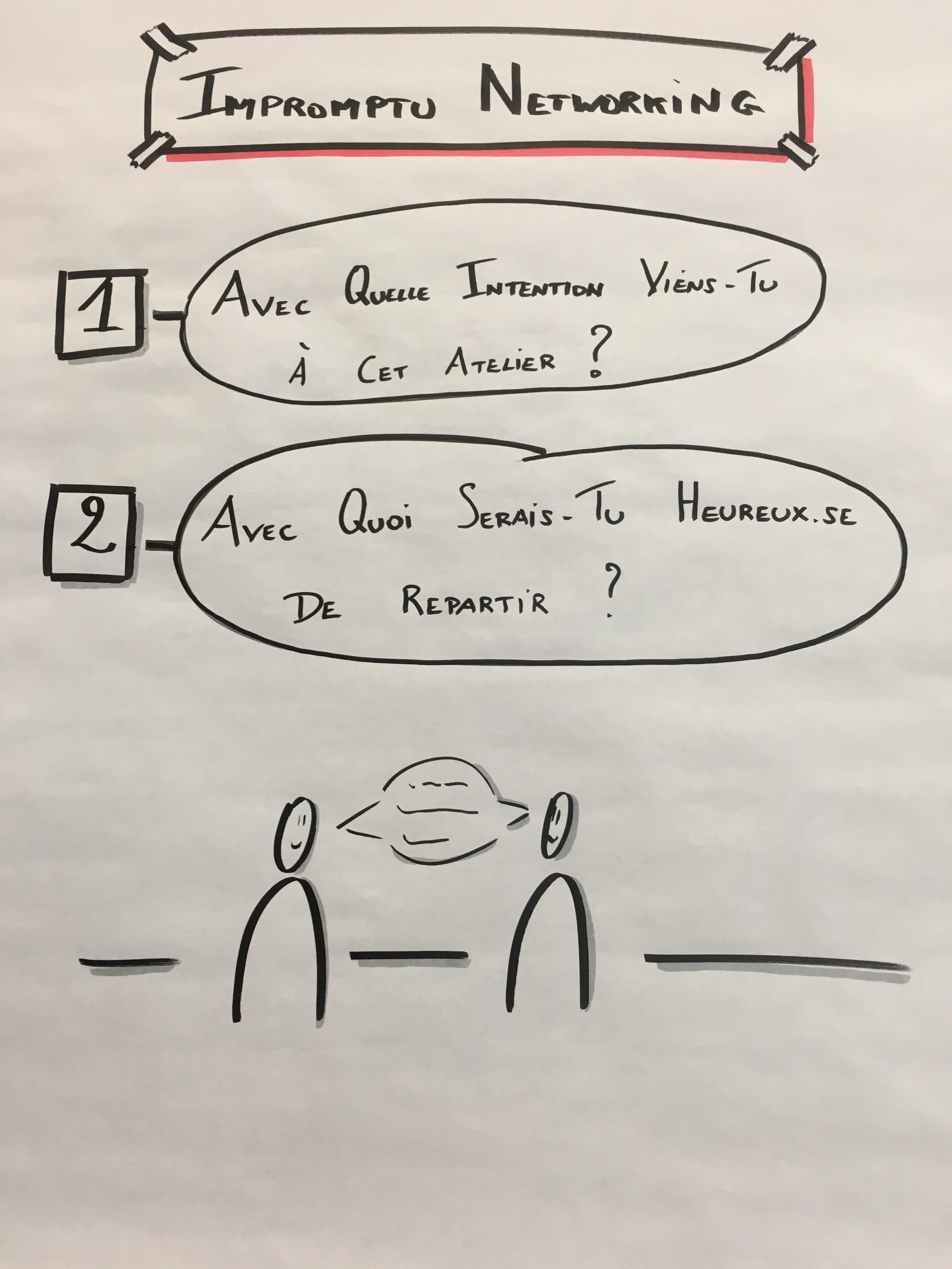
Il est 10h05, nous démarrons donc « comme prévu » avec l’Impromptu Networking.
J’invite les participants à former des binômes dans lesquels ils vont devoir répondre tour à tour, pendant 2 minutes, aux questions suivantes :
- Avec quelle intention viens-je à cet atelier ?
- Avec quoi serais-je heureux.se de repartir ?
Nous changerons de binôme 3 fois.
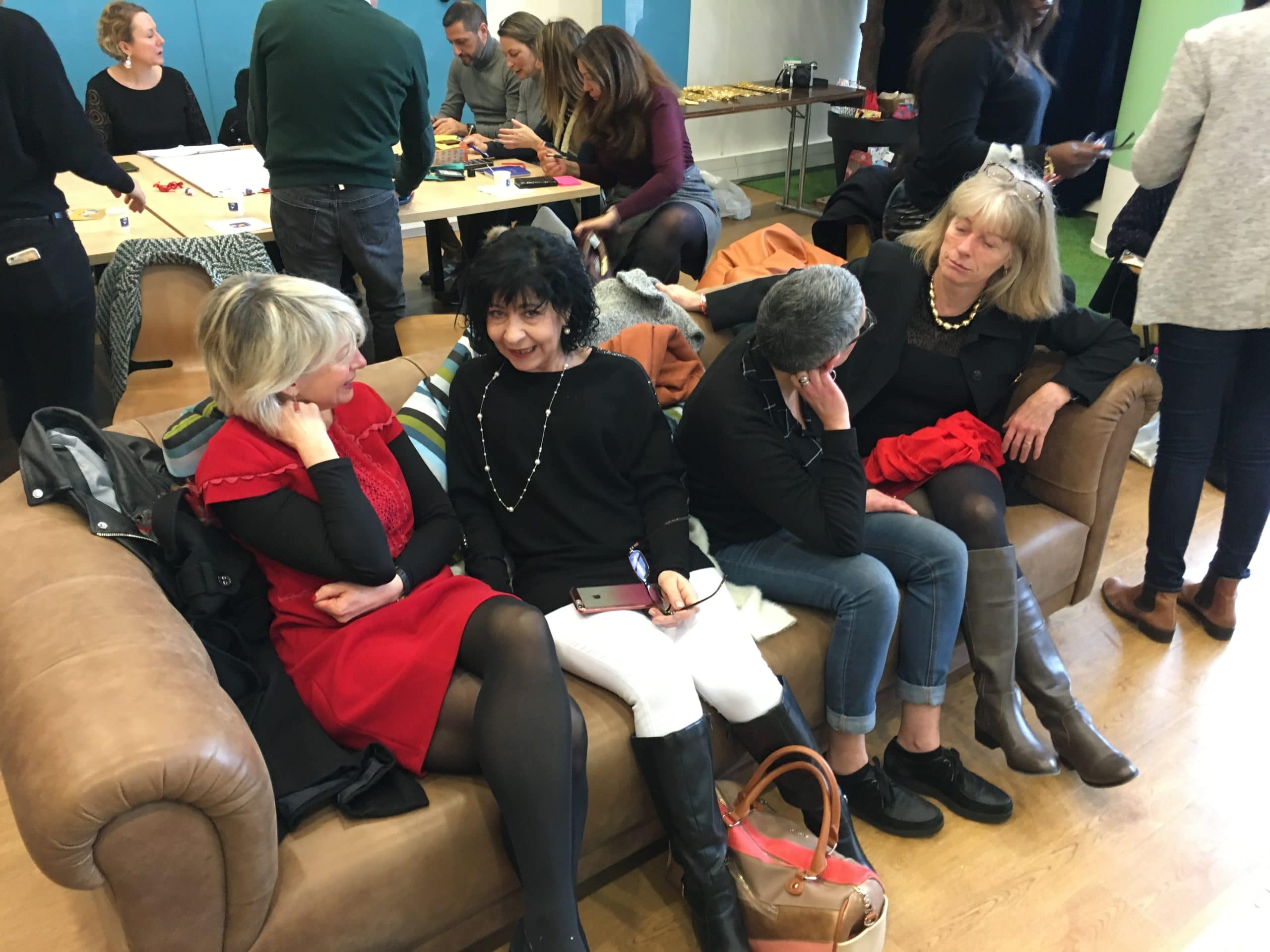
1er Tour
Malgré la simplicité de la structure, j’ai pour ma part été un peu mal à l’aise au début. En effet, j’ai eu le sentiment que le groupe avait des difficultés à démarrer et que potentiellement 2 minutes par personne serait un peu long. J’ai donc joué un peu sur le temps au premier tour en ne laissant qu’1mn30 par personne.
2ème tour
Le moment du switch est toujours périlleux : soit il se passe dans la fluidité, soit les personnes sont perdues et n’arrivent pas à trouver rapidement un.e partenaire.
Dans mon cas, les personnes se connaissant déjà, les choses se sont plutôt bien passées même si la plupart du temps les profils ne se sont pas trop mélangés. En effet, cette année le groupe comportait une part importante d’apprenti.e.s – non habitué.e.s à ce genre d’exercices – et qui sont généralement resté.e.s ensemble pendant l’exercice.
Ce n’est pas grave, l’idée de cette partie est simplement de mettre un petit peu en mouvement les personnes dans tous les cas ! 😉
Le 2ème tour s’est alors passé tranquillement. Les personnes ayant déjà passé le premier tour savaient déjà plus ou moins quoi dire. Il était intéressant de voir que dans ces nouveaux binômes, chacun allait plus facilement chercher ce que l’autre avait à dire. J’ai donc opté pour les 2mn par personne ce coup-ci.
3ème tour
Le 3ème tour fut particulièrement fluide. En effet, l’exercice étant connu, les changements se font rapidement et les discussions sont immédiatement investies par les personnes. Les 2 mn chacun sont donc bien remplies et il m’est d’ailleurs plus difficile d’arrêter les échanges entre binôme ! 😛
J’ai été étonné par l’énergie dégagée par ce petit exercice. Après un débriefing rapide avec les participants, je les invite à le réutiliser lors de leurs prochaines rencontres, au besoin !
| Note : Ayant considéré l’ajustement du timing nécessaire, j’ai tenté de gagner un peu de temps sur cette partie sachant qu’elle n’était là que pour préparer le terrain aux autres ! 😛 |
Nous enchaînons alors sur le fameux SPA ! 🙂
SPA

Il est 10h25, on est bon dans le timing et on enchaîne avec le SPA pour créer une ambiance chaleureuse pour les participants.
Étape 1 : Conversation entre coach et client
J’invite alors les participants à se mettre par groupe de 3 avec :
- Un coach : qui va poser un certain nombre de questions (4 dans notre cas)
- Un client : qui va devoir répondre à chacune des questions pendant 2 minutes
- Un observateur : qui va être un témoin supplémentaire de la conversation
Chacun membre du groupe prendra ensuite tour à tour les différents rôles.
Les questions du coach sont alors les suivantes :
- Que retiens-tu de positif – dans l’activité du groupe – en 2018 ?
- Comment y as-tu contribué ?
Comme vous avez pu le voir, les 2 questions suivantes n’ont pas été indiquées sur l’affiche. L’idée étant de leur garder la surprise ! 😉
Nous lançons alors le premier tour dans lequel je rappelle chaque question au fur et à mesure.
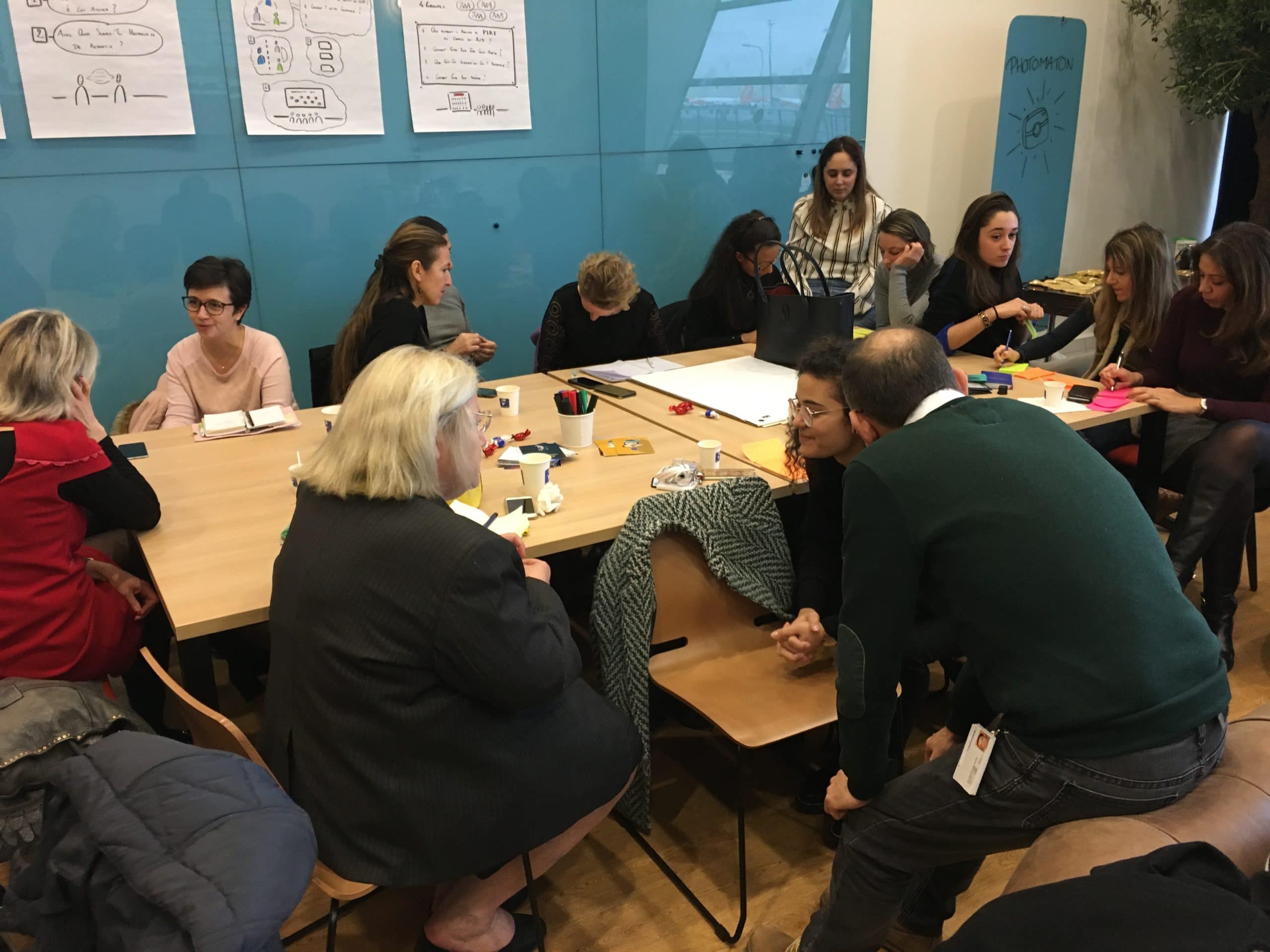
Lorsque nous arrivons à la 3ème question, je leur indique que la suivante est :
Quoi d’autre ?
Lorsque nous arrivons à la 4ème question, avec un léger temps d’attente, je leur indique que la suivante est :
Quoi d’autre ?
Après quelques signes d’étonnement et quelques sourires, les participants se prêtent au jeu et continuent leurs conversations !
On échange ensuite les rôles. Les tours se passent de manière plutôt fluide sachant que le premier tour avait fait office de chauffe. Je m’efforce néanmoins d’accompagner le groupe en rappelant les questions et en maintenant le timing. Le « quoi d’autre ? » se transforme en jeu, il est énoncé par les participants avant même que j’ai eu le temps de le dire ! 😛
A la fin du temps imparti, nous débriefons rapidement sur l’exercice qui vient d’avoir lieu : une participante indique que le « quoi d’autre ? » était extrêmement puissant et pousse l’autre à aller chercher plus loin et à approfondir ses idées ! Je leur partage que c’est une des armes favorites des coachs ! 😉
Une belle découverte on dirait, tant mieux ! 🙂
Étape 2 : Conversation entre Coach et Observateur
Lorsque tout le monde est passé, nous passons à la phase suivante : la vraie phase de SPA ! 🙂
J’invite alors chaque groupe à se positionner de la manière suivante :
- Le coach et l’observateur se mettent face à face (ou côte à côte si pas le choix) afin de pouvoir avoir une conversation
- Le client leur tourne le dos mais tend l’oreille afin d’avoir la possibilité d’entendre ce qu’il se dit
- Le coach et l’observateur discute pendant 2 minutes de ce qu’ils ont retenu de ce qui a été exprimé par le client lors de la première étape : les événements importants, les gestes du client, les mots qu’il ou elle a utilisé et qui ont retenu leur attention…
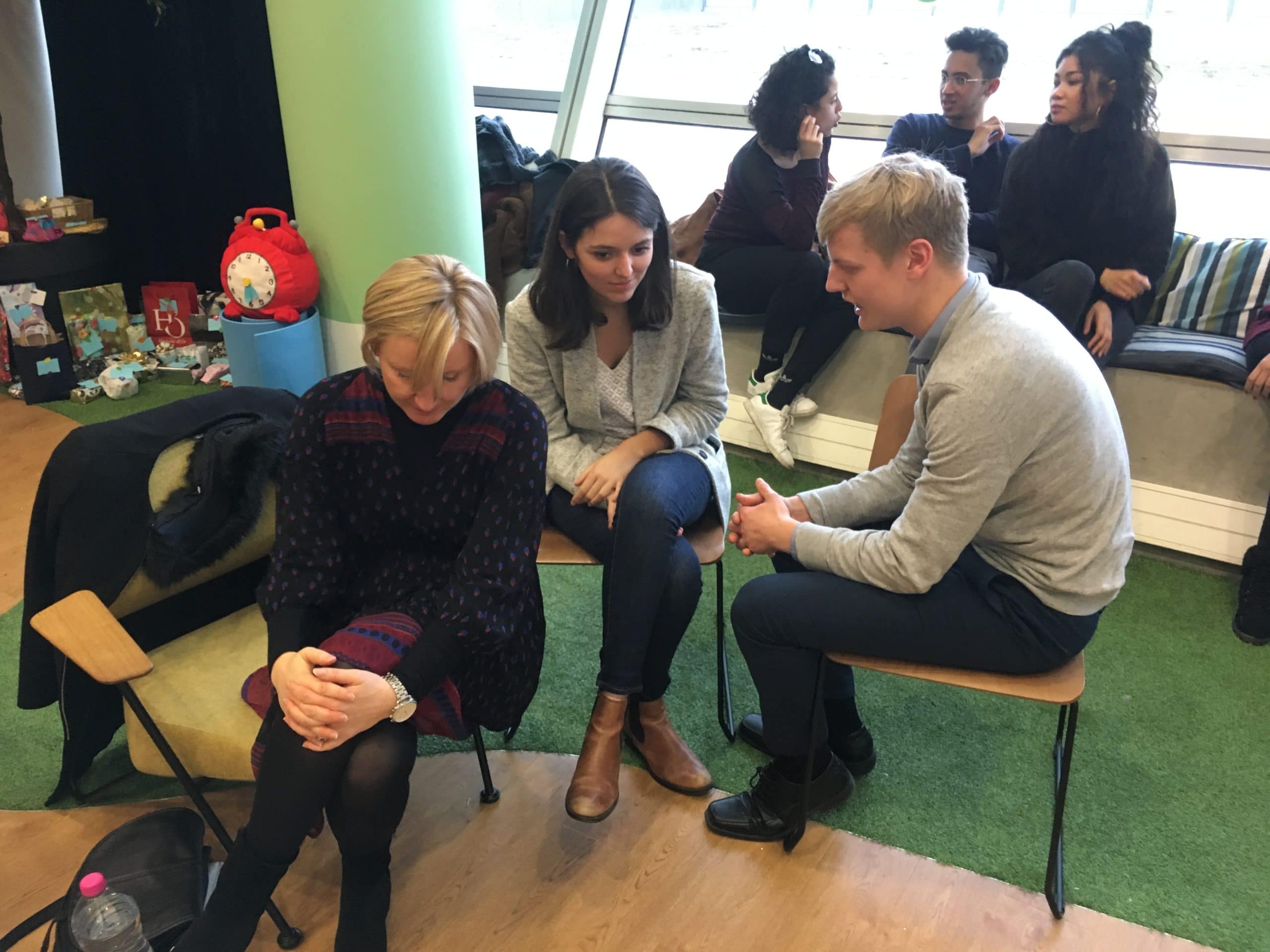
Chaque personne passera donc chacune à son tour pendant 2 minutes dans son SPA.
En observant les différents groupes, j’ai trouvé que l’ambiance qu’amenait cet atelier était très positive. En effet, la plupart des client(e)s avaient le sourire aux lèvres à l’écoute de cette conversation qui les concernait. C’est également une manière d’obtenir du feedback indirectement sur les messages que l’on a pu envoyer et d’avoir une vision alternative sur nos propos.
Difficile d’arrêter les groupes lorsque cela fait tant de bien ! 😛
Il était néanmoins temps de clôturer la partie Rétrospective de la session avec les étapes 3 et 4 !
Étape 3 et 4 : Sélection et partage des idées principales
Afin de pouvoir avoir une vision globale de 2018, j’invite chaque groupe à sélectionner les 3 grandes idées qui ont pu émerger de leurs échanges et de les inscrire sur des Post-Its. Ce sont ces 3 grandes fiertés qui vont être partagées au groupe complet. Je leur laisse 5 minutes.

Je demande ensuite à chacun de venir tour à tour déposer son Post-It sur une surface plane au vu de tous et de dire quelques mots rapides pour expliquer l’idée derrière les mots inscrits. Commence alors un mouvement de groupe et un ensemble de mots qui résonnent dans la pièce : voici ce que 2018 a représenté pour eux !
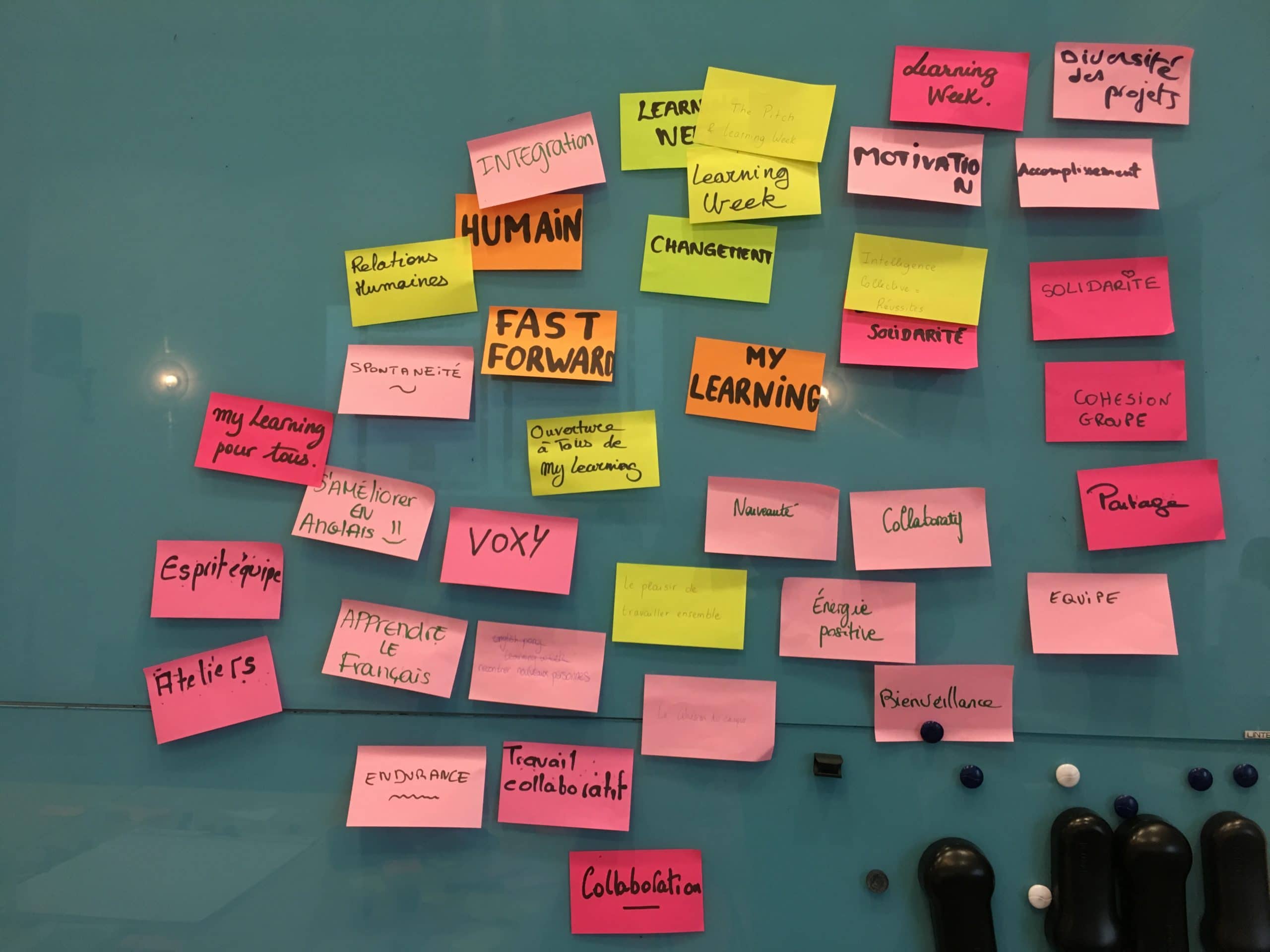
On pourrait croire que pour une rétrospective, le livrable final est un peu léger. Je ne suis pas de cet avis car cela dépend de ce que l’on regarde. En effet, une rétrospective n’est pas un moment où l’on va lister de manière exhaustive tout ce que l’on a fait, tout ce qui s’est mal passé et ce que l’on devrait faire. Pour moi, c’est un moment de partage avant tout dont on ne doit garder que l’essence pour pouvoir avancer : le nuage de mot final correspond à cette essence.
Pour les détails, chaque personne a eu la possibilité de s’exprimer en groupe restreint afin de garantir une plus grande intimité et donc, espérons le, une plus grande ouverture.
11:25 c’est l’heure de la pause, je demande aux participants de revenir à 11:37 pétantes… ce qui n’arriva bien évidemment pas ! 😛
Nous reprenons vers 11:45 ce qui risquait de mettre en péril l’atteinte de l’objectif dans les temps impartis. Même si Movers and Shapers est un atelier rapide, j’ai décidé de faire l’impasse pour pouvoir garder suffisamment de temps pour les échanges et le débriefing : maximiser la valeur dans le temps imparti, Agile vous avez dit ? 😉
TRIZ
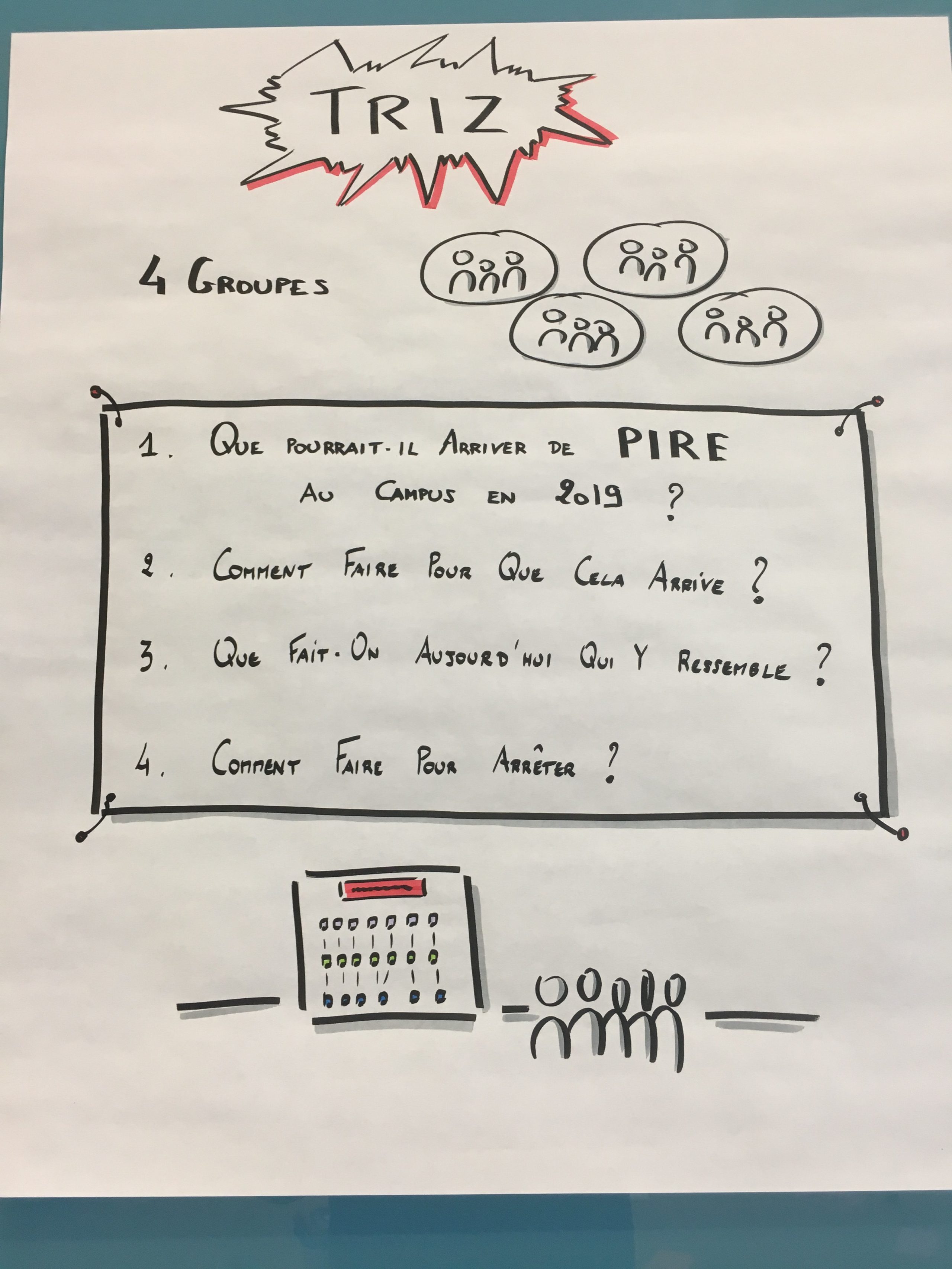
Pour commencer, j’invite l’ensemble des participants à former 4 groupes. A la différence du plan initial, j’ai décidé de faire travailler ces 4 groupes de manière indépendante et de faire des regroupements potentiels à la fin.
En effet, au vu du nombre de personnes et de la diversité des profils, j’ai estimé qu’il était plus pertinent de s’ouvrir les options sur 4 grands thèmes que de se focaliser sur un thème qui ne toucherait peut-être pas tout le monde. Nous verrons bien s’il y a des recoupements ! 🙂
Étape 1 : Définir le pire résultat
Dans un premier temps, chaque groupe va être amené à répondre à la question suivante :
Que pourrait-il arriver de pire pour nous en 2019 ?

Pour ce faire, je les invite à utiliser la structure du 1-2-4-Tous :
- 1 minute de réflexion individuelle
- 2 minutes à 2 pour échanger sur les idées de chacun
- 4 minutes à 4 pour comparer les similitudes et différences des idées
- 5 minutes en sous-groupe complet pour sélectionner l’idée maîtresse émergeant de leurs discussions
| Note : bien évidemment on garde la même logique, toute idée est inscrite sur un Post-it, une idée par Post-it. |
Lorsque chacun des sous-groupes s’est mis d’accord sur son pire résultat, je les invite à les partager rapidement aux autres afin de donner un avant-goût des sujets qui vont être étudiés.
Étape 2 : Stratégie pour y arriver
Cette étape ressemble énormément à ce que j’utilise dans ma structure de Kick-off.
En effet, j’invite chaque personne à écrire tout ce qu’ils pourraient mettre en oeuvre pour atteindre ce pire résultat. Une idée, un Post-it, comme d’habitude.
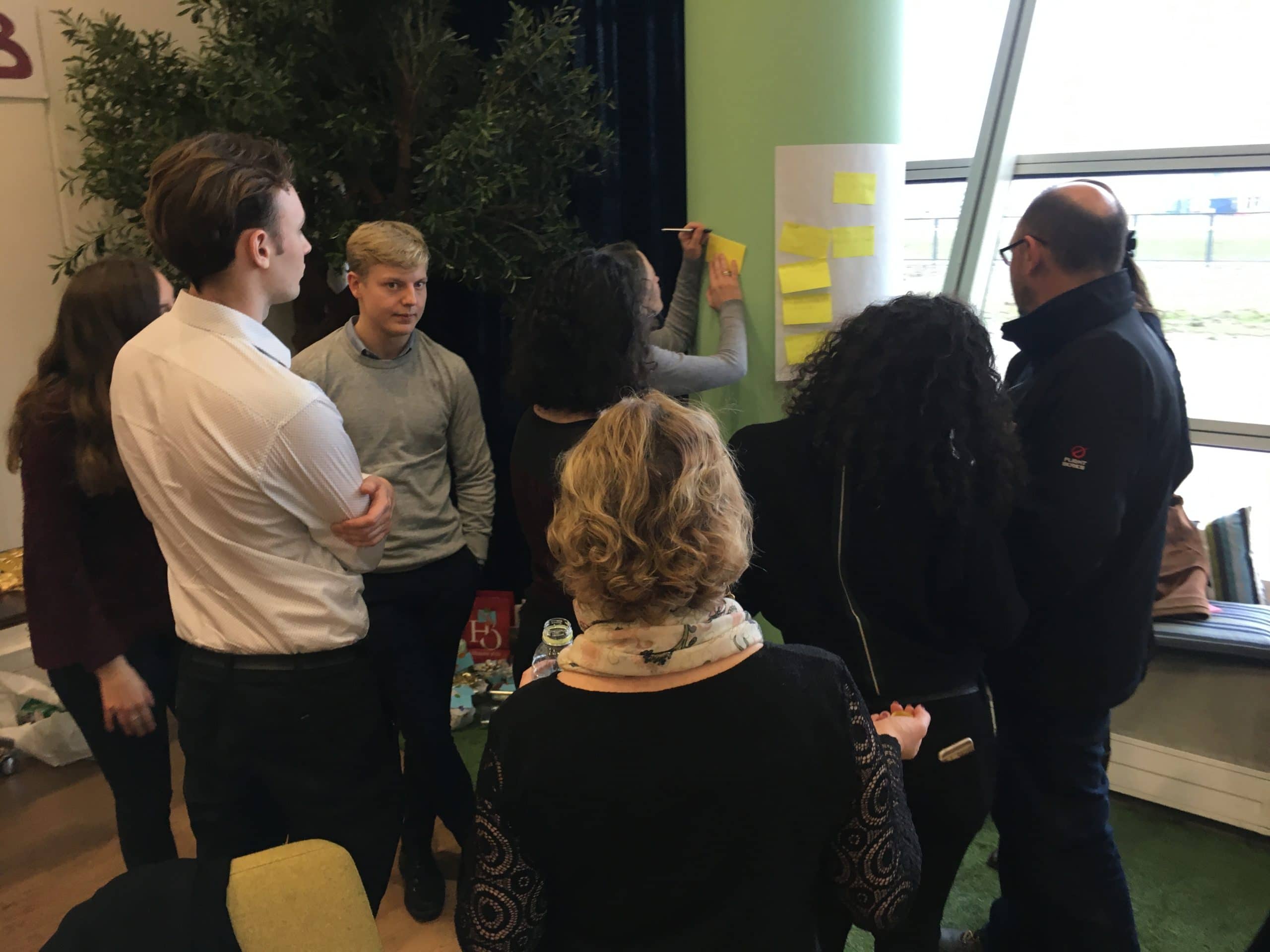
Une des difficultés que j’observe ici est dans le démarrage. Toutes les idées sont bonnes à prendre et j’encourage chaque groupe à ne rien mettre de côté.
Étape 3 : Auto-dénonciation
Cette 3ème étape est clé dans le processus. En effet, on invite les participants à regarder à nouveau la liste construite précédemment et à faire le parallèle avec ce qu’il se passe aujourd’hui.
Que faites-vous aujourd’hui qui ressemble (de près ou de loin) à ce que vous avez évoqué dans votre liste précédente ?

Une des grandes difficultés ici est dans ce que l’on pourrait appeler l’auto-dénonciation. Pas dans le sens où les personnes sont de mauvaise foi et ne veulent pas admettre certaines choses mais plutôt dans le sens où il est nécessaire de voir les choses sous un angle différent.
Regarder ce que l’on fait aujourd’hui qui, même sans en avoir l’intention, a un impact négatif sur le groupe et sur les objectifs que l’on souhaite atteindre. Une chose importante sur laquelle j’insiste est de regarder au niveau des choses sur lesquelles on a la main, pas des choses que l’on peut voir de loin et qui sont actionnées par d’autres (sinon l’exercice n’aurait pas beaucoup de sens).
L’exercice n’est pas facile et je m’efforce de passer dans chacun des groupes pour aider les participants à regarder les choses sous des angles différents. Je remonte même avec un groupe à l’étape précédente dans les stratégies de mises en oeuvre du pire résultat afin d’évoquer plus d’options avec eux. L’idée principale est de générer des échanges afin d’ouvrir les perspectives du groupe.
| Note : Je pense que notre rôle en tant que facilitateur est là, accompagner dans la réflexion, proposer des options et laisser la libre responsabilité de choix aux personnes que l’on accompagne. |
Étape 4 : Arrêter les actions non constructives
Pour cette dernière étape du TRIZ, j’invite les participants à définir des actions pour arrêter / modifier des éléments de la liste dernièrement élaborée.
Autrement dit,
Que pouvez-vous faire pour arrêter de faire des choses qui sont contre-productives aujourd’hui ?
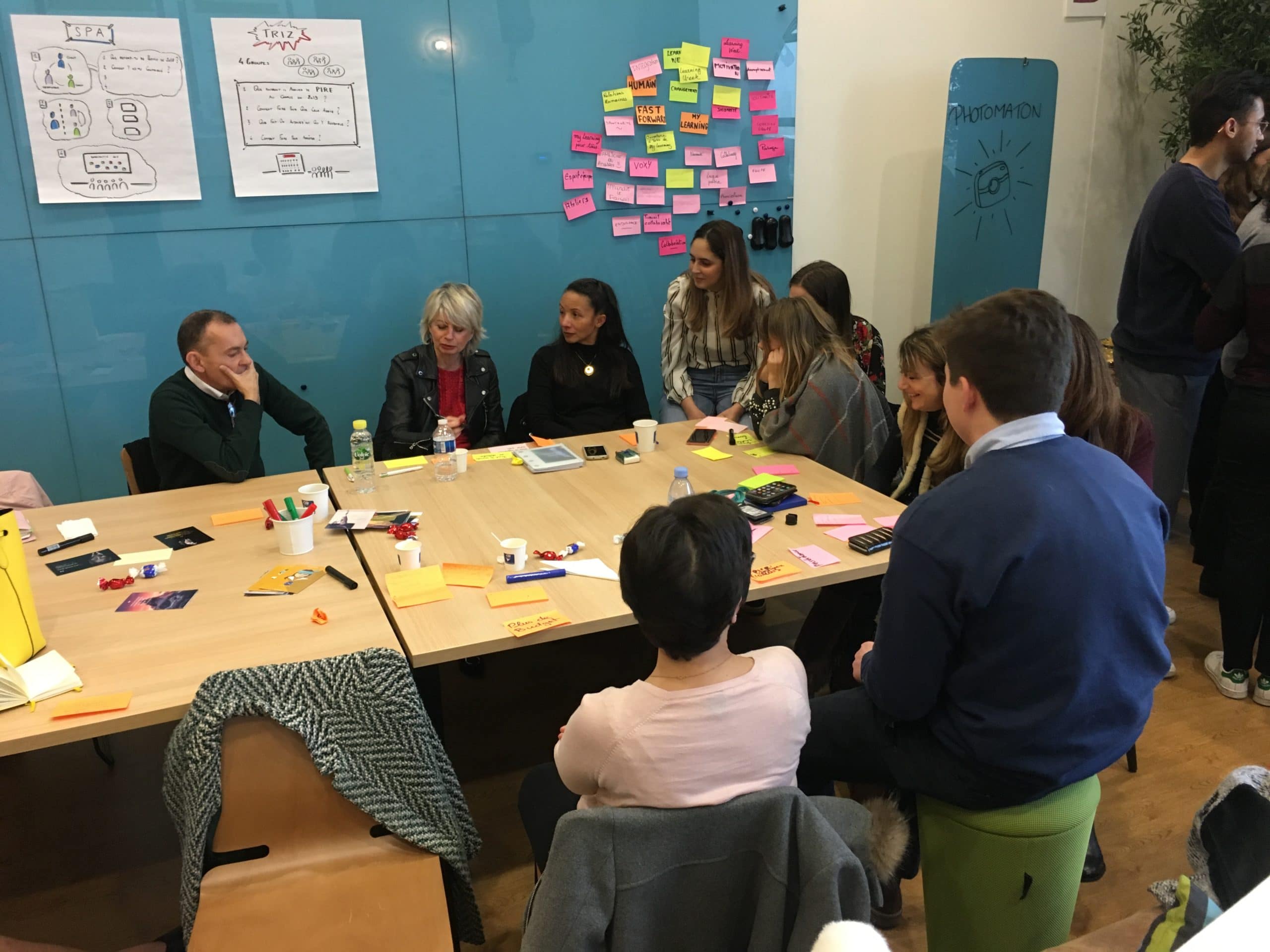
Lorsque l’on passe à une phase d’élaboration de solutions, les idées se génèrent la plupart du temps assez facilement. Ce à quoi je fais attention encore une fois est de rendre les idées les plus actionnables possibles en posant des questions du type :
- Est-ce suffisamment concret pour tout le monde afin de pouvoir mettre cela en place demain ?
- Peux-tu préciser ce que tu entends par « se faire confiance » ?
- Est-ce que cette action est dans votre main ?
- …
A la fin du temps imparti, nous allons dans la phase finale de l’exercice, le débriefing en groupe complet.
Débriefing
Pour cette dernière étape, j’invite chaque groupe à donner le résultat de sa réflexion aux autres en précisant :
- Sa problématique initiale : dit autrement, son pire résultat
- Ses pistes pour avancer
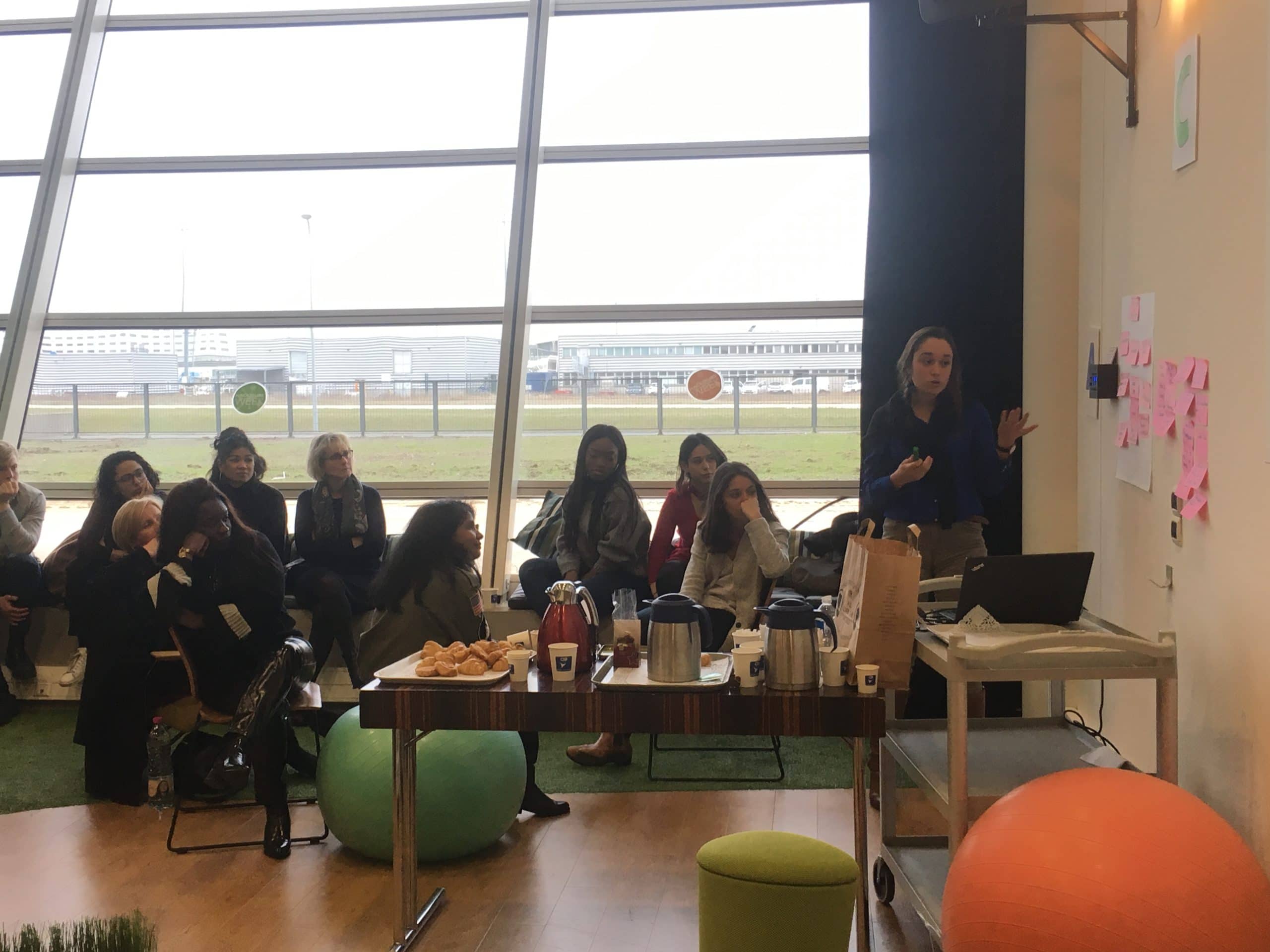
Une personne me précisait qu’il était difficile de faire le lien logique entre la problématique et les idées d’action sans passer par le cheminement. Je l’invite donc à présenter la chose comme elle le sens : il m’apparaît important d’aller dans le sens de l’énergie des participants, surtout lorsque c’est constructif ! 🙂
Le débriefing se déroule de manière fluide et les différents groupes passent un à un en expliquant leurs résultats.
On se rend alors compte que 2 groupes, ayant pourtant des problématiques différentes, se retrouvent avec des actions assez similaires ! La beauté de l’émergence, n’est-ce pas ? 😉
En regardant ma montre avec attention et le dernier groupe, je vois 12:28. Je remercie le dernier groupe ainsi que l’ensemble des personnes pour leur participation et je clôture l’atelier !
Conclusion

Cette expérience des Liberating Structures fut plutôt satisfaisante de mon côté ! J’ai été étonné de la puissance de ces structures, qui malgré leur simplicité, ont vraiment eu la possibilité de faire émerger de belles choses dans ce groupe d’une trentaine de personnes.
Un feedback client allant dans ce sens :
Un grand merci de toute l’équipe pour ton intervention.
Des outputs encore riches d’enseignements pour nous et une belle animation fédératrice.
Bravo à toi!
J’espère que cet article aura pu vous donner une vision de la mise en oeuvre des Liberating Structures, en tout cas une manière de faire. Je pense que j’en testerais d’autres à l’avenir et je vous invite vivement à faire de même ! 😉






